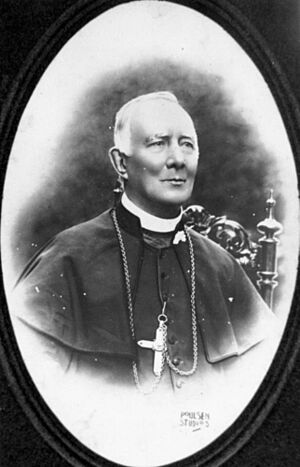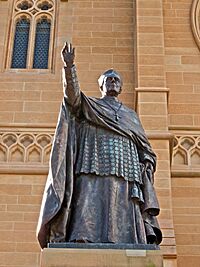Francis Moran (cardinal) facts for kids
Quick facts for kids His Eminence Patrick Francis Moran |
|
|---|---|
| Cardinal, Archbishop of Sydney | |

|
|
| Archdiocese | Sydney |
| Enthroned | 1884 |
| Reign ended | 1911 |
| Predecessor | Roger Vaughan |
| Successor | Michael Kelly |
| Other posts | Bishop of Ossory (1872–1884) Cardinal-priest of Santa Susanna (1885-1911) |
| Orders | |
| Ordination | 19 March 1853 |
| Consecration | 5 March 1872 |
| Created Cardinal | 27 July 1885 |
| Rank | Cardinal-priest |
| Personal details | |
| Born | 16 September 1830 Leighlinbridge, County Carlow, Ireland |
| Died | 16 August 1911 (aged 80) Sydney, Australia |
| Buried | St. Mary's Cathedral, Sydney |
| Nationality | Irish |
| Denomination | Roman Catholic Church |
| Parents | Patrick Moran Alicia Mary Cullen |
| Alma mater | Irish College, Rome |
| Coat of arms |  |
Patrick Francis Moran (born September 16, 1830 – died August 16, 1911) was an important leader in the Catholic Church. He became the third Archbishop of Sydney. He was also the very first cardinal appointed from Australia.
Contents
Early Life and Education
Patrick Moran was born in Leighlinbridge, County Carlow, Ireland, on September 16, 1830. His parents were Patrick and Alicia Cullen Moran. Sadly, his parents passed away by the time he was 11 years old.
In 1842, when he was 12, Moran left Ireland. He traveled with his uncle, Paul Cullen, to Rome. There, he studied to become a priest at the Irish College.
Moran was a very bright student. He earned his doctorate (a high academic degree) very quickly. By the age of 25, he could speak ten different languages. He spent a lot of time finding and editing old documents about Irish church history. Some of his edited works are still important sources today.
Early Career
After his studies, Moran became the vice-rector (a type of assistant leader) at the Irish College. He also taught Hebrew at another important college called Propaganda Fide. For a while, he was also vice-rector of the Scots College in Rome.
In 1866, Moran became the secretary for his uncle, Cardinal Paul Cullen, in Dublin. He also taught scripture at Clonliffe College in Dublin. He started a religious magazine called the "Irish Ecclesiastical Record." Later, he used this as a model for a similar magazine in Australia.
In 1869, he went with Cardinal Cullen to the First Vatican Council. This was a very important meeting for the Catholic Church. It was at this council that the idea of papal infallibility was officially defined. This means that the Pope cannot make mistakes when speaking about faith or morals. Many believe Moran helped write the proposal for this important teaching.
Bishop of Ossory
On December 22, 1871, Moran was appointed as a coadjutor bishop for the Ossory in Ireland. This meant he would help the current bishop and take over when that bishop left. He became a bishop on March 5, 1872.
When Bishop Edward Walsh died, Moran became the Bishop of Ossory on August 11, 1872. As bishop, he supported the Home Rule movement. This movement wanted Ireland to have more control over its own government. Even the British Prime Minister, W. E. Gladstone, asked for Moran's advice on this topic.
Becoming a Cardinal in Australia
Pope Leo XIII personally chose Patrick Moran to lead the Archdiocese of Sydney. This was a big change because the previous archbishops had been English. Moran arrived in Australia on September 8, 1884.
On July 27, 1885, Moran was made a cardinal. He was given the title of St Susanna. As the new Irish-Australian cardinal, he quickly became a strong leader.
Moran changed how St Patrick's Day was celebrated in Sydney. He started having a special Mass at St. Mary's Cathedral, Sydney on that day. Over time, the celebrations became more about showing Irish Catholic strength and unity.
Travels and Achievements
Cardinal Moran traveled widely to support the Church. In 1886, he traveled about 2,500 miles across land and sea. He visited all the Catholic dioceses in New Zealand. In 1887, he traveled 6,000 miles to Perth to consecrate (officially bless) another bishop. He also visited many other cities in Australia to consecrate their cathedrals.
Moran supported the rights of workers to improve their conditions. This was after a special letter from the Pope called Rerum Novarum was released in 1891.
During his time as archbishop, Moran consecrated 14 new bishops. He also ordained almost 500 priests and dedicated more than 5,000 churches. He helped over 500 nuns join their religious orders. He traveled to Rome five times between 1885 and 1903 for church business. However, he could not attend the papal election of 1903 because of the long distance and short notice.
Federation and Later Life
Moran was a strong supporter of Federation. This was the movement to unite the Australian colonies into one country. In November 1896, he attended a meeting about Federation in Bathurst.
In March 1897, Moran tried to be elected as a delegate for the Australasian Federal Convention. Even though he said he would attend as an individual, his candidacy caused some debate. He was not elected, but still received many votes.
Cardinal Moran passed away in Manly, Sydney, in August 1911. He was 80 years old. His funeral procession through Sydney was huge. A quarter of a million people attended, which was the largest crowd ever in Australia at that time. He is buried in St. Mary's Cathedral, Sydney.


